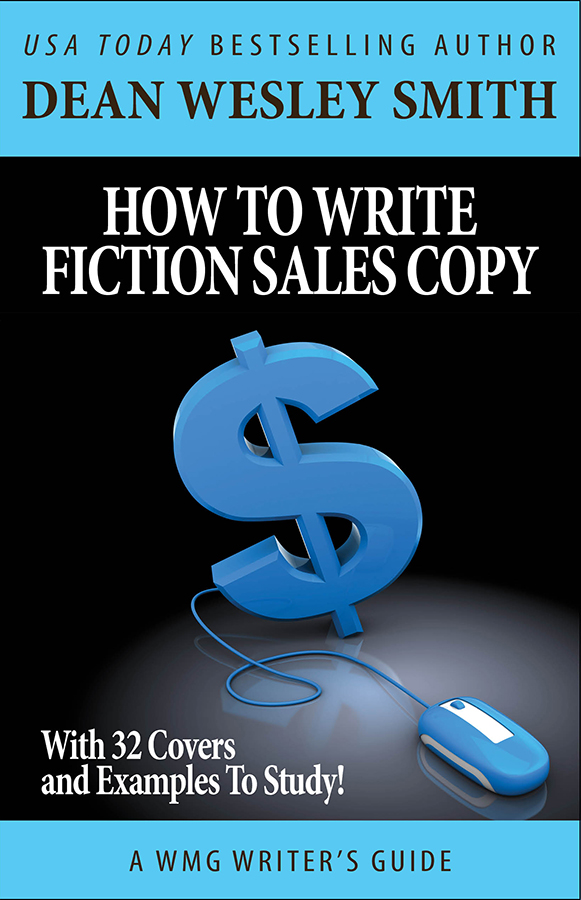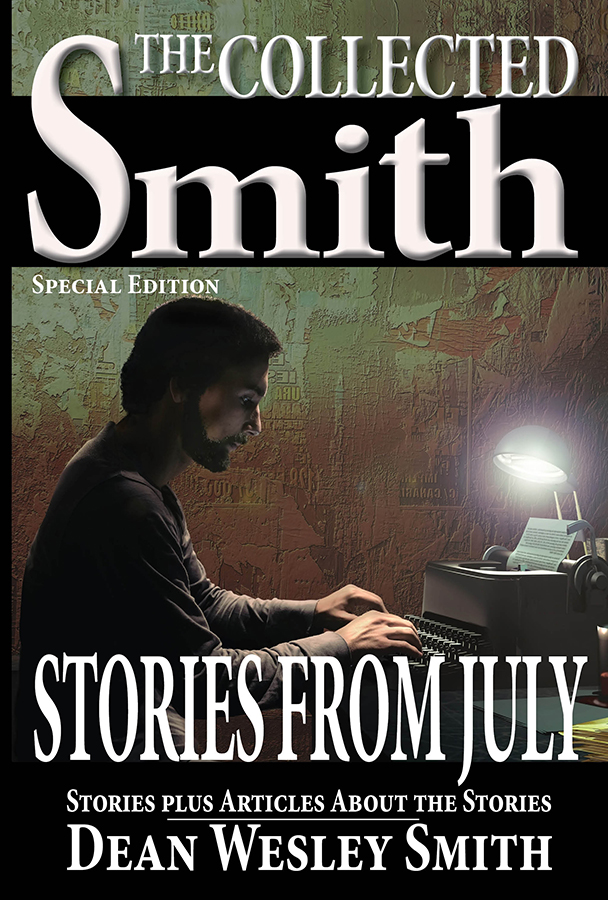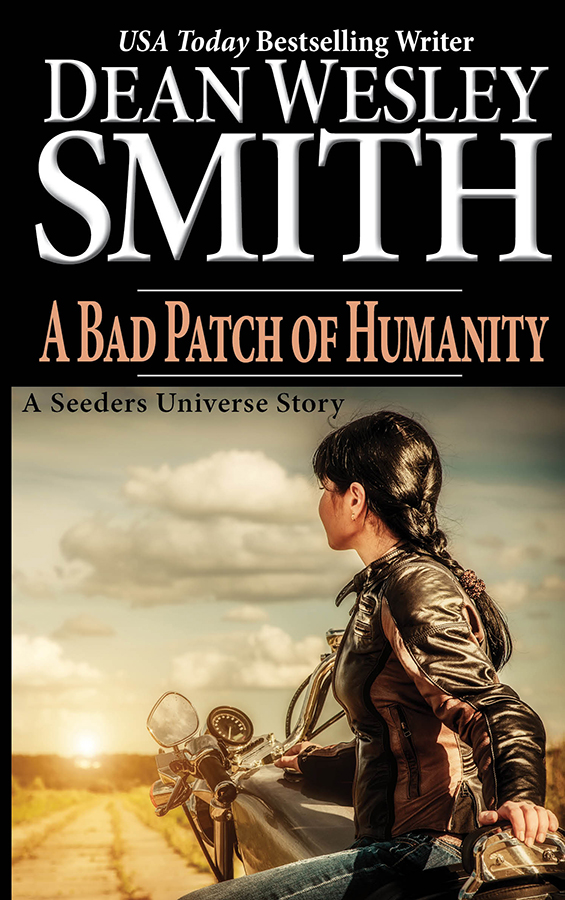How to Write Fiction Sales Copy: Introduction and Chapter One
HOW TO WRITE FICTION SALES COPY
INTRODUCTION

In July of 2015, I managed to write one short story a day. Actually had one extra, so ended up with 32 stories.
I did a cover for all of those stories as well, usually the next day.
My goal seemed simple on the surface:
— Write 31 or 32 short stories.
— Put them all in a book titled Stories from July.
— Later publish all of them as stand-alone stories in electronic and paper.
— Also put each story in my monthly magazine (Smith’s Monthly) one or two a month, mixed with other stories and new novels.
— Include the stories in theme collections.
In the book Stories from July, I wanted the blogs about writing each story, a cover, a blurb, and then the story.
To do that, I needed first to write the story each day. Check. Got that done. And it was great fun, more fun than I had imagined it would be.
Second, I needed to do a cover for each story, branded to me, the author. Check. Got that done. Also fun.
And third, each story needed some sales copy. It would need it for the blurb on all the sales sites and for the back cover on the paper versions of each story and at the start of each story in Stories from July and in Smith’s Monthly.
So that’s what this series is all about.
Sales copy.
I need to write the sales copy for all 32 stories. So a couple people asked about how I was going to do that. So I figured why not explain some about how to write the sales copy, since I also teach doing this in a workshop among other things.
I will include my thinking about each story as I wrote the sale copy for it and how I got out of author problems and wrote sales.
Maybe I can help a few writers with their own sales copy if I talk about this process and show examples. At least that’s the hope.
So onward.
–
CHAPTER ONE
I figure the best way to do this is just start with the very first story I wrote on July 1st and work my way though each one. I will put the covers here with the blurbs.
A few basic thoughts about sales copy writing first off.
This is difficult for most fiction writers to do for a couple of reasons, both of which I call “The Author Problem.”
I will go into this more lately, but the author problem comes in basically two parts.
First… Can’t see beyond the plot.
Second… Can’t write anything but passive voice when talking about their own work.
Keep that in mind as I dive into these first few. In later chapters I will deal a lot with more details about “The Author Problem” in writing sales copy.
I’m going to put up two blurbs I wrote for the first two stories and then talk about them in this first chapter before moving on.
—

The Case of the Dead Lady Blues: A Pilgrim Hugh Incident
Private Detective Pilgrim Hugh loves solving strange cases. Very little stumps him for very long.
But a woman by the name of Deep Blue, dead in her empty apartment and dyed blue, seemed like an impossible case.
And more than Hugh knows depends on his quick solution.
Pilgrim Hugh once again rides to the rescue in his stretch limo driven by his brilliant assistant. If you love puzzle crime stories, grab “The Case of the Dead Lady Blues.”
—
—

A Bad Patch of Humanity: A Seeders Universe Story
Most of humanity died one ugly day four years before. Now the survivors wanted to rebuild.
Angie Park’s job consisted of telling survivors outside of Portland, Oregon, of the plans to rebuild. But some survivors wanted nothing to do with civilization.
And some thought killing worth the price to pay to stay alone.
In the galaxy-spanning Seeders Universe, “A Bad Patch of Humanity” focuses down on an early event in Angie Park’s life, an event that starts her on her path to becoming a woman of legend in a hundred galaxies.
—
—
So first, let me talk about a pattern I used for these two, and that I will continue to use through a lot of these stories.
Blurb Pattern… Basic
(Paragraph one)… Character or world summary. Interesting. And nails genre if possible.
(Paragraph two)… One very short paragraph with short sentences about the first page of the plot.
(Paragraph three)… Plot kicker line.
(Paragraph four)… Why readers will want to read the story (mostly using tags).
That is a structure that works well for short stories and most novels. It isn’t the only structure by a long ways, but it is a standby basic structure to fall back on.
–
My Thinking About Each Story
The Case of the Dead Lady Blues: A Pilgrim Hugh Incident
This is a story using a developing character. I think I have done four or five of these stories now. All strange. So when I came to write the blurb, I had a couple givens that were easy.
First, I needed to explain Pilgrim Hugh slightly and what he did. Thus the summary paragraph about him.
That also nails the genre.
Plot opens basically with him standing in an empty apartment looking at a dead body that had been dyed blue. So I just described that since the scene was interesting enough to hook a mystery reader into wondering how a body in an empty apartment could be dyed blue.
Then I raised the stakes with a hint at something bigger in the story. (Third paragraph.) Always good to raise the stakes without giving plot away.
Then I told readers with a hint of the strangeness of Pilgrim Hugh that readers didn’t want to miss this story. A form of call to action.
–
A Bad Patch of Humanity: A Seeder’s Universe Story.
This story presented more problems for me in a number of ways. First off, after this next month, all Seeder’s novels will have massive spaceships on them. But this story is basically an opening story of a new character. So I needed a cover to the story. (Story opens with her getting off her motorcycle.)
Then I needed the blurb to address in a fashion the questions of those who read the Seeder’s Universe novels.
So first paragraph set the scene.
Second paragraph introduced the character and the plot.
Third paragraph raised the stakes.
Fourth paragraph told the reader this was stand alone, but also how this story fit into the larger Seeder’s Universe. This time the last paragraph set the genre.
And readers love start-of-legend stories.
–
Author Problem
Look at both sales copy for the author problem.
First off, how you know you have too much plot is if you have two or more “and then this happens.”
I had none.
Not a one.
The plot I revealed in these two first blurbs a reader would know in the first page or so of each story.
Second… notice there is not a passive verb anywhere. Every verb is active. Sentences are short. Easy for a buyer to read.
So more examples and forms and analysis in the next chapters as I run through these 32 stories. Stay tuned.
11 Comments
Melisa
Thank you! I hate writing blurbs because all the advice was always “sum up your novel and hook the reader” but never gave me hints on how to present 150k words in 200 without being unreadable. This is the first succinct, example driven advice I’ve seen that explains how and why you are doing this.
I swear one of these years I am coming to your conferences in Oregon. Or Superstars of writing. Just time and money are currently preventing me. But thank you again for your and Kris’s incredible generosity in sharing your knowledge.
dwsmith
We have all the online workshops and lectures as well, Melisa. Much, much cheaper. (grin)
And on that note, once this is done, maybe I should put this up as a lecture as well. Hmmm, we shall see if I can say more than I can write. And if the structure ends up being a lecture-like structure.
Michael Kelberer
One of the best short lessons in the business of being an author I’ve seen in a while – great job! Conceptual take-away for me was that your blurb is basically like your cover and opening – hint, tease, hook
J.M. Ney-Grimm
Oh, wow! So this one is going to be a book also? I WANT this book. I am ALWAYS looking to improve my copy writing abilities, and I want this book on my shelf, so that I can review it every time I have copy to write for a new release. THNAK YOU, Dean!
dwsmith
Yup, another short book. WMG Publishing is putting together a nice catalog of these kinds of books. I think it must be getting up to around 20 or more writer and freelancer help books, the anchor being the monster Freelancer’s Survival Guide by Kris which is just flat stunning.
David Anthony Brown
This is fantastic and a huge help. I’ve always struggled with writing sales copy, and have gotten better but still looking for ways to improve. A little formula to practice with will help. Thanks 🙂
Dane Tyler
Dean, this is going to be a fantastic series! I can’ t WAIT for the whole thing to unfold. This has been such a black box for me, and I’ve already learned some things that are going to help me going forward. Or, y’know…backward. When I have to *ahem!* rewrite my existing blurbs. (Sorry!)
One quick question: You said the blurbs for both of these only describe what happens on the first page of each story. If doing this for a novel, do you make that the first chapter, or first scene, Act? How is that extrapolated over a longer story to still engage/hook the reader?
Again, thank you for being a great teacher, willing to share your knowledge with so many. And if the answers to my questions are coming in later chapters, I’ll be patient. 🙂
All my best.
dwsmith
In this case, never hurts to answer this now. Actually, yes, first chapter. Not much more. Part of the author problem I’ll talk about is that the author has this cool scene in their minds that is halfway through the book and think that would be what sells the book. Actually, it only disappoints readers because they already know what is going to happen and thus takes all the power out of your book.
So yes, first chapter at most. The key is not give readers much plot, but instead tell them what the book is about. Two very different things, but very difficult for early writers to understand.
Think of it in crass terms…
“A heart-felt romance between a man with no arms and a woman with no legs.” That’s what the book is about.
Plot is… John Henry meets Betty Sue in a laundromat. He’s using a stick in his mouth to get his clothes out of the dryer. She helps him. And then they end up having lunch. And then he saves her from a rabid dog by kicking the dog. And then… And then…
Author problem makes authors writing blurbs go down into plot.
Gnondpom
Thank you so much for sharing all your knowledge! It is impressive how in so little words you can explain a way of doing a good blurb, after having seen so many bad ones that give away half the plot! It is also the problem with reviews, even though some reviewers alert the reader before giving the worst spoilers some of them don’t, sometimes probably without knowing.
But I think the worst example of how NOT to write a blurb comes from the film industry: some movie trailers give away ALL the plot. Apparently they wanted to show all the cool action scenes (or funny/romantic/scary moments, depending on the movie), so that the spectator thinks: what a cool movie, I really want to go and watch that one.
The problem is that once you actually watch the movie you feel betrayed: nothing really new has been added, you would have been better off only watching the very short movie that was the trailer. And next time you might just stop at that, which is not how an author will build an audience.
Felicia Fredlund
What timing you have, Dean! Yesterday I was to sit down and write a blurb. Guess which structure I used? 🙂
I sent it to a friend, and she liked it. So, onward to the next stage of that release.
J. D. Brink
I’m basically going to echo what everyone else has said. Thanks for sharing your wisdom on a topic that most of us are sorely in need of help on! And for relating to each story as a unique problem so we can see those wheels turn.
(Also, by the way, I am no longer deploying to the Mid East. Home again and preparing to start the next book. *Whew*)